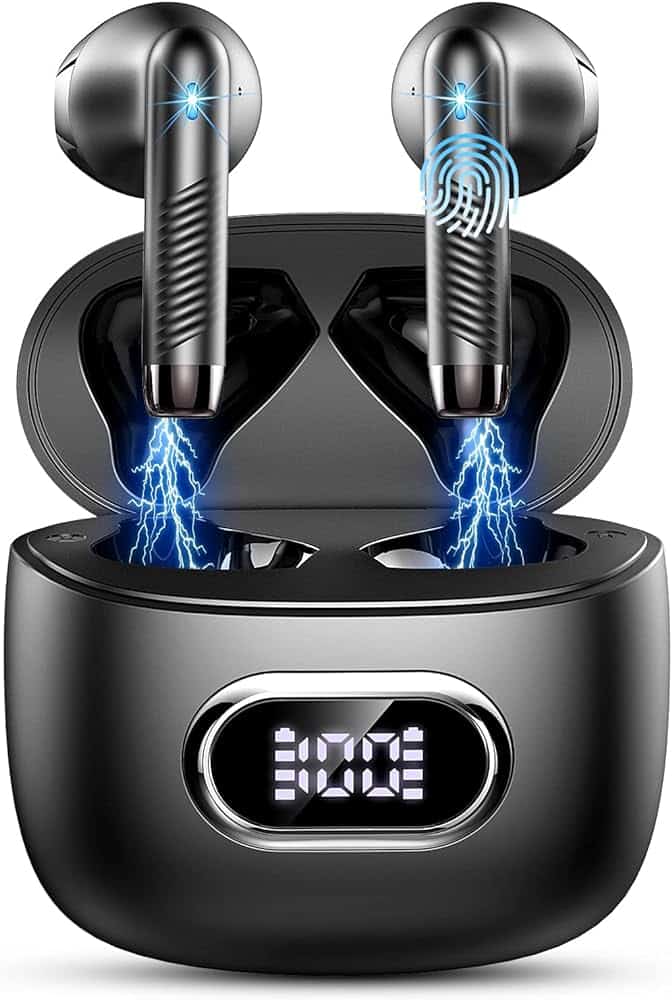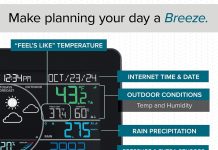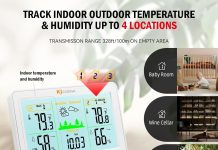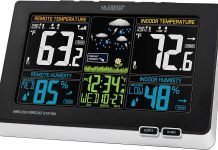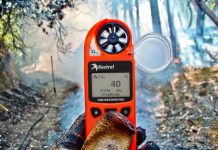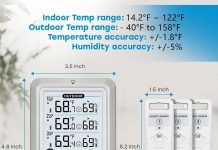Have you ever wondered how far away you can be and still have access to the data from your home weather station? Whether you’re lounging on a tropical beach or trekking through a remote mountain range, the desire to stay connected to the conditions back home is undeniable. In this article, we explore the surprising range of accessibility for home weather station data and uncover the fascinating ways technology has bridged the gap between our wanderlust and our need for accurate and up-to-date weather information. So, grab your passport and get ready to embark on a journey of weather tracking like never before!
Review contents
Factors that affect the range of accessing home weather station data
When it comes to accessing home weather station data, there are several factors that can influence the range at which we can access the information. These factors include signal transmission technology, obstructions between the weather station and receiver, interference from other electronic devices, and the quality of the signal strength and antenna. By understanding these factors, we can make informed decisions to optimize the range of accessing home weather station data.
Signal transmission technology
The choice of signal transmission technology plays a significant role in determining the range of accessing home weather station data. Different wireless technologies, such as Wi-Fi, Bluetooth, Zigbee, and RF (Radio Frequency), offer varying ranges. It is important to consider the range capabilities of each technology when selecting a home weather station.
Obstructions between the weather station and receiver
Obstructions between the weather station and the receiver can hinder the range of accessing home weather station data. Buildings, trees, and other structures can block or weaken the signal, resulting in reduced range. It is important to consider the physical environment where the weather station will be placed to minimize the impact of obstructions.
Interference from other electronic devices
The presence of other electronic devices in the vicinity can cause interference and affect the range of accessing home weather station data. Appliances, routers, and other radios emitting signals on similar frequencies can disrupt the communication between the weather station and the receiver. To optimize the range, it is essential to minimize the interference from other electronic devices.
Signal strength and antenna quality
The signal strength and antenna quality of the weather station and receiver directly impact the range of accessing home weather station data. Weather stations with stronger signals and higher quality antennas can transmit data over longer distances. Similarly, receivers with powerful antennas can capture signals from a greater range. Considering signal strength and antenna quality can help maximize the range of accessing home weather station data.
Wireless technologies commonly used in home weather stations
Several wireless technologies are commonly used in home weather stations. Let’s explore each technology and understand how they can affect the range of accessing home weather station data.
Wi-Fi
Wi-Fi is one of the most popular wireless technologies used in home weather stations. It offers a relatively long range, typically reaching up to a few hundred feet indoors and even more outdoors, depending on the router’s capabilities. The range of accessing home weather station data through Wi-Fi can be extended by using Wi-Fi range extenders or mesh networks.
Bluetooth
Bluetooth is another commonly used wireless technology in home weather stations. It offers a shorter range compared to Wi-Fi, usually up to 100 feet in ideal conditions. The range of accessing home weather station data through Bluetooth can be limited, especially in larger homes or areas with obstructions. Using signal boosting devices or deploying additional antennas can help extend the range.
Zigbee
Zigbee is a low-power, short-range wireless technology commonly used in home automation systems, including some home weather stations. Its range is typically limited to around 50 to 100 feet indoors, which may be suitable for smaller homes or apartments. To extend the range of accessing home weather station data through Zigbee, additional devices called repeaters can be strategically placed to relay the signals.
RF (Radio Frequency)
RF, or Radio Frequency, is a wireless technology that operates on various frequencies. It is commonly used in older or simpler home weather stations. The range of RF-based weather stations can vary significantly depending on the specific frequency used and the quality of the transmitter and receiver. In general, RF-based weather stations have a shorter range compared to Wi-Fi or Bluetooth. Using signal boosting devices or deploying additional antennas can help enhance the range.
Maximum range limitations of popular wireless technologies
While each wireless technology offers a range for accessing home weather station data, it is important to understand their maximum limitations. Knowing these limitations can help set realistic expectations and make informed decisions when selecting a home weather station.
Wi-Fi range
Wi-Fi typically offers a range of up to a few hundred feet indoors and even more outdoors. However, factors such as the quality of the router, signal interference, and obstructions can impact the effective range. In ideal conditions, home weather stations using Wi-Fi can provide access to data from several hundred feet away from the receiver.
Bluetooth range
Bluetooth has a relatively limited range compared to Wi-Fi. In ideal conditions, it can reach up to 100 feet. However, obstacles and interference can significantly reduce the effective range. Access to home weather station data through Bluetooth is typically restricted to a range within the same room or nearby area.
Zigbee range
Zigbee has a shorter range compared to Wi-Fi or Bluetooth, usually reaching up to 50 to 100 feet indoors. However, this range can be extended by strategically placing repeater devices throughout the home, ensuring that the signals can reach the receiver from different locations.
RF (Radio Frequency) range
The range of RF-based weather stations can vary depending on the specific frequency used and the quality of the transmitter and receiver. In general, the range of RF-based weather stations is shorter compared to Wi-Fi or Bluetooth. It is common for RF-based weather stations to have a range of up to a few hundred feet.
Extending the range of home weather station data access
To extend the range of accessing home weather station data, several strategies and devices can be utilized. Let’s explore some methods that can help optimize the range and ensure reliable access to the weather data.
Using Wi-Fi range extenders
Wi-Fi range extenders, also known as wireless repeaters or boosters, can help extend the range of accessing home weather station data through Wi-Fi. These devices amplify and retransmit the Wi-Fi signal, effectively increasing the coverage area. By strategically placing range extenders throughout the home, the signal strength can be boosted, allowing for access to weather data from farther distances.
Deploying additional antennas
Adding additional antennas to the weather station and receiver can help enhance the range of accessing home weather station data. High-gain antennas can capture and transmit signals over greater distances, overcoming obstructions and interference. By upgrading the antennas of both the weather station and the receiver, the range of accessing the weather station data can be significantly extended.
Setting up a mesh network
Setting up a mesh network can improve the range and reliability of accessing home weather station data, especially when using Wi-Fi or Zigbee technologies. Mesh networks consist of multiple interconnected devices, creating a network with extensive coverage. Each device in the network acts as a node, relaying signals to ensure optimal communication between the weather station and the receiver. By strategically placing mesh network nodes throughout the home, extended coverage can be achieved, enhancing the range of accessing weather station data.
Using signal boosting devices
Signal boosting devices, such as signal amplifiers or repeaters, can also help extend the range of accessing home weather station data. These devices enhance the signal’s strength and quality, allowing it to travel further distances and overcome obstacles and interference. Signal boosting devices can be particularly useful when dealing with RF-based weather stations or when needing to extend the range of Bluetooth or Zigbee technologies.
Real-world examples of home weather station data access range
To further illustrate the range of accessing home weather station data in different scenarios, let’s explore three real-world case studies.
Case study 1: Urban environment with buildings and obstructions
In an urban environment with tall buildings and various obstructions, accessing home weather station data can pose challenges. The presence of concrete structures and interference from other electronic devices can diminish the signal strength and limit the range. However, by using Wi-Fi range extenders strategically placed throughout the living space and deploying additional antennas for both the weather station and the receiver, it is possible to overcome these obstacles and achieve a satisfactory range of accessing the weather station data.
Case study 2: Suburban neighborhood with moderate interference
In a suburban neighborhood with moderate interference, accessing home weather station data can be relatively straightforward. As the interference is not as pronounced as in an urban environment, Wi-Fi or Bluetooth technologies can provide satisfactory range coverage. By ensuring a high-quality router and receiver with powerful antennas, the access to weather station data can extend to neighboring houses or even a few blocks away.
Case study 3: Rural area with limited obstructions
In a rural area with limited obstructions, accessing home weather station data can be more straightforward. The open surroundings offer fewer obstacles and less interference, allowing for better signal propagation. Weather stations using Wi-Fi, Bluetooth, Zigbee, or RF technologies can provide extended range coverage, enabling access to weather data from significantly farther distances compared to urban or suburban areas.
Factors to consider when choosing a home weather station
When selecting a home weather station, multiple factors should be considered to ensure optimal range and functionality. Let’s explore these factors in detail.
Intended location for the weather station
Consider where the weather station will be placed within your home or property. Depending on the location, factors such as obstructions, interference, and the distance to the receiver can vary. If the weather station will be in a densely populated urban area, using Wi-Fi or other technologies with longer range capabilities would be more suitable.
Type of wireless technology used
The choice of wireless technology used in the home weather station directly impacts the range of accessing the data. Consider the pros and cons of each technology discussed earlier in the article, such as Wi-Fi, Bluetooth, Zigbee, and RF, and choose the one that aligns with your specific range requirements.
Data transmission range specifications
Review the data transmission range specifications provided by the manufacturer of the home weather station. These specifications give an estimate of the maximum range at which the weather station can securely transmit data to the receiver. Ensure that the specified range aligns with your desired coverage area.
Budget and affordability
Budget and affordability are important considerations when choosing a home weather station. Advanced features, longer range capabilities, and higher quality components may come at a higher cost. Consider your budgetary constraints and find a balance between affordability and the desired range of accessing home weather station data.
Alternative methods for accessing home weather station data remotely
In addition to directly accessing home weather station data, there are alternative methods that allow for remote access. Let’s explore some of these methods.
Using dedicated smartphone apps
Many home weather station manufacturers provide dedicated smartphone apps that allow users to access the weather station data remotely. These apps can provide real-time data updates and allow users to monitor and analyze the weather conditions from anywhere with an internet connection.
Interfacing with home automation systems
Integrating the home weather station with a home automation system provides an alternative method for accessing the weather station data remotely. Home automation systems can collect and consolidate data from various sensors, including the weather station, and allow users to access the information through a centralized interface or mobile app.
Cloud-based data storage and access
Some home weather station systems offer cloud-based data storage and access. With this method, the weather station data is securely stored in the cloud, allowing users to access the information from anywhere with an internet connection. Cloud-based solutions provide convenience and accessibility, especially for users who frequently travel or are away from their primary residence.
VPN (Virtual Private Network) for remote access
For advanced users concerned about security and privacy, setting up a Virtual Private Network (VPN) can provide a secure method for remote access to home weather station data. By using a VPN, users can establish a secure, encrypted connection to their home network, allowing them to access the weather station data remotely without compromising privacy.
Security and privacy considerations
When accessing home weather station data remotely, it is essential to consider security and privacy measures. Let’s explore the factors to consider.
Encryption and authentication protocols
Ensure that the home weather station system utilizes strong encryption and authentication protocols to protect the transmission of data. Look for systems that support industry-standard encryption methods, such as HTTPS or WPA2, and have robust authentication mechanisms in place.
Data privacy policies of manufacturers
Review the data privacy policies of the home weather station manufacturers to understand how they handle and protect the collected data. Ensure that the manufacturer follows best practices and complies with relevant privacy regulations to safeguard your personal information.
Secure access methods for remote data retrieval
If accessing home weather station data remotely, use secure access methods, such as HTTPS or VPNs, to ensure that your connection and data transmission are encrypted. Avoid accessing the data over unsecured or public networks to minimize the risk of unauthorized access or data breaches.
Future advancements in accessing home weather station data
As technology continues to evolve, we can expect future advancements that will further enhance the range and accessibility of home weather station data. Let’s explore some potential advancements on the horizon.
Emerging wireless technologies
In the future, we may see the emergence of new wireless technologies specifically designed for home weather stations. These technologies may offer increased range, improved signal strength, and better resistance to interference, allowing for even more reliable and extended access to weather station data.
Improved signal strength and range
Advancements in signal strength and range capabilities are also expected in existing wireless technologies like Wi-Fi, Bluetooth, Zigbee, and RF. Manufacturers may develop new hardware and protocols that optimize signal transmission, resulting in extended range and enhanced reliability when accessing home weather station data.
Integration with smart home ecosystems
The integration of home weather stations with smart home ecosystems is likely to become more seamless in the future. This integration will allow users to access weather station data alongside other smart home devices and systems, enabling sophisticated automation and data-driven decision-making.
Enhanced data analytics and visualization
Advancements in data analytics and visualization technologies will further improve the usability and value of home weather station data. Future developments may include enhanced weather forecasting algorithms, personalized insights, and intuitive visualizations that make it easier for users to interpret and utilize the collected data.
Conclusion
Accessing home weather station data remotely is a valuable tool for monitoring, analyzing, and utilizing weather information. The range of accessing the data is influenced by factors such as signal transmission technology, obstructions, interference, and signal strength. By understanding these factors and utilizing appropriate strategies, such as using Wi-Fi range extenders, deploying additional antennas, setting up mesh networks, and utilizing signal boosting devices, we can optimize the range and ensure reliable access to home weather station data.
When choosing a home weather station, it is important to consider factors such as the intended location, wireless technology used, data transmission range specifications, and budget. Additionally, alternative methods for accessing the data remotely, such as dedicated smartphone apps, interfacing with home automation systems, cloud-based storage, and VPNs, provide flexibility and convenience.
Regarding security and privacy, encryption and authentication protocols, data privacy policies, and secure access methods should be considered to protect personal information and ensure secure data transmission.
As technology continues to advance, we can expect future improvements in wireless technologies, signal strength and range, integration with smart home ecosystems, and data analytics and visualization. These advancements will further enhance the accessibility and usability of home weather station data, enabling us to make more informed decisions based on accurate and up-to-date weather information.

